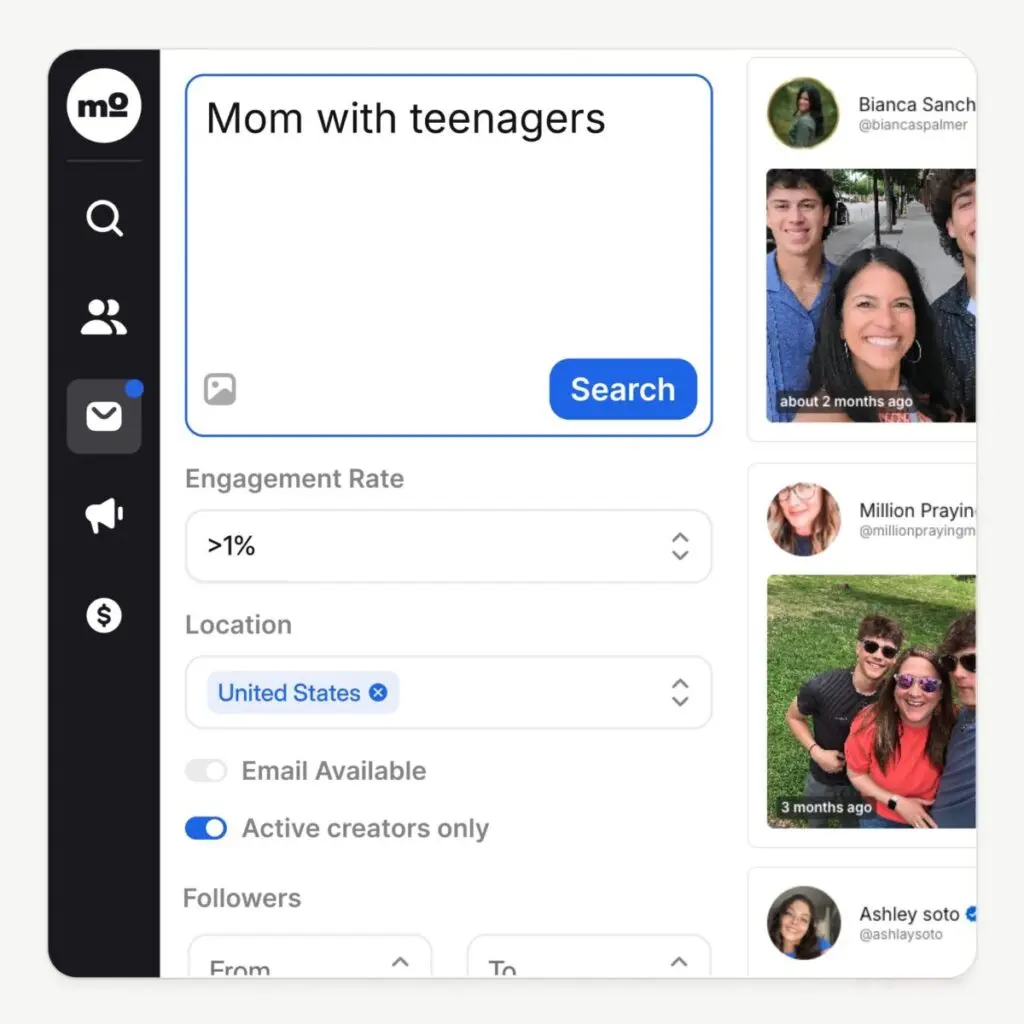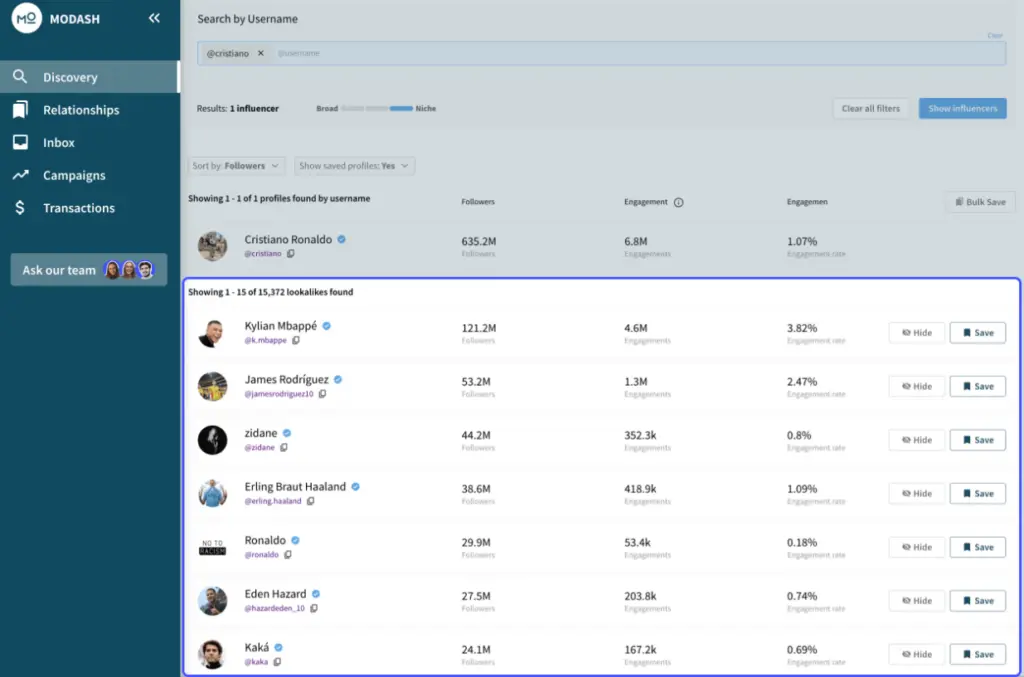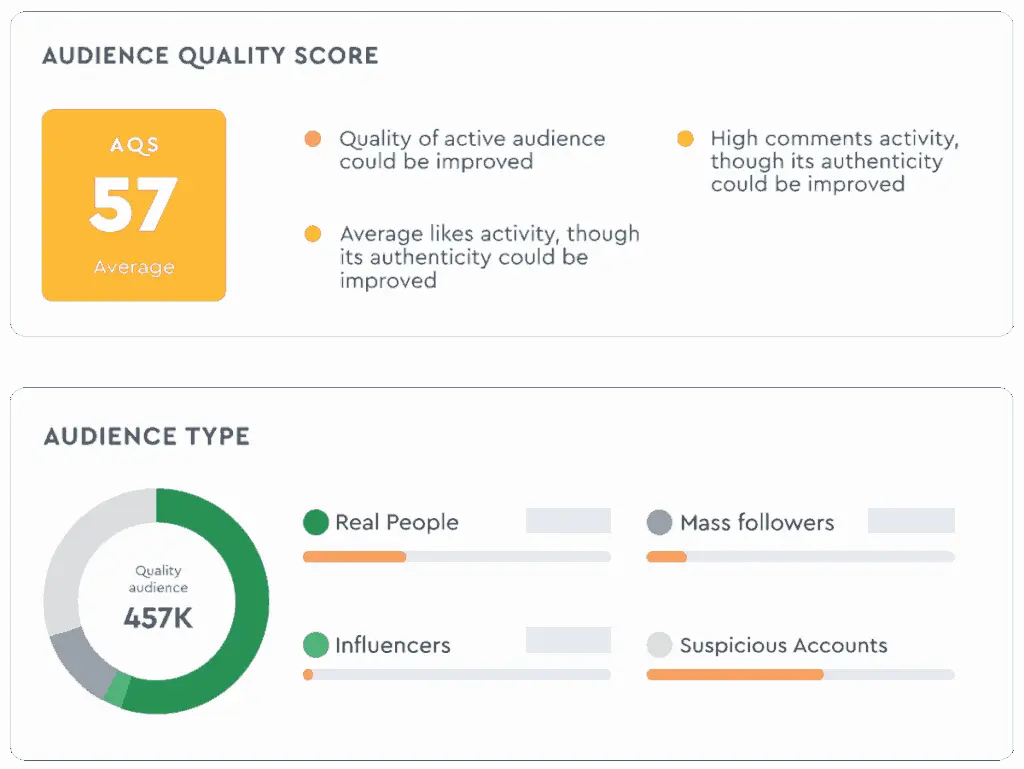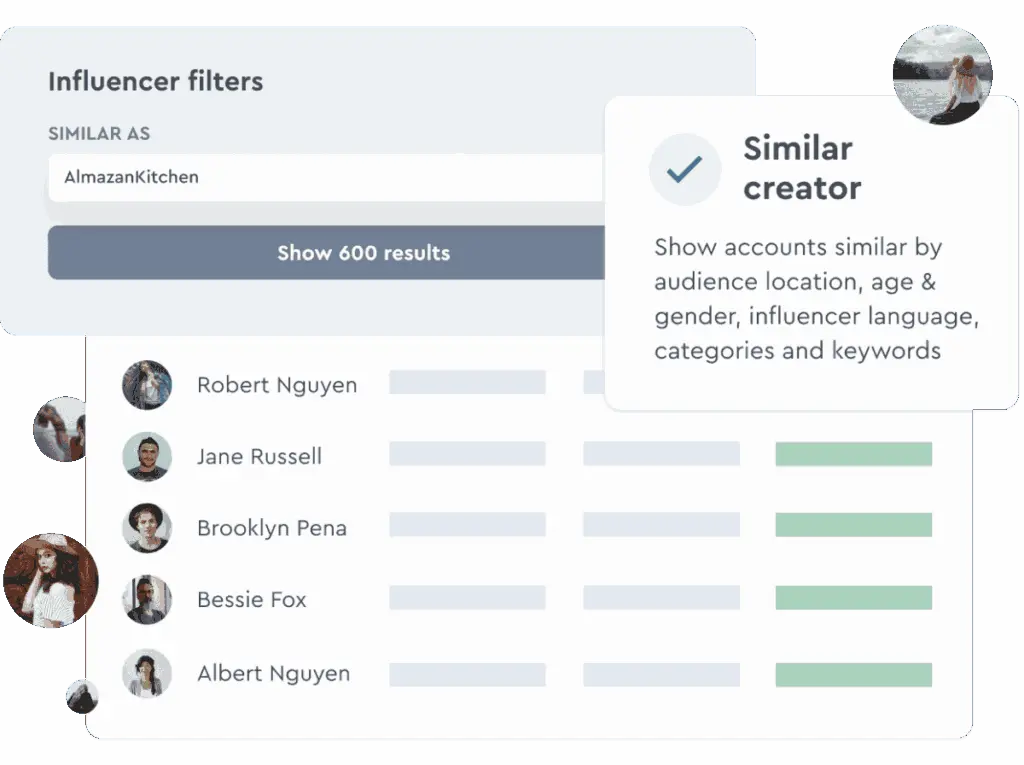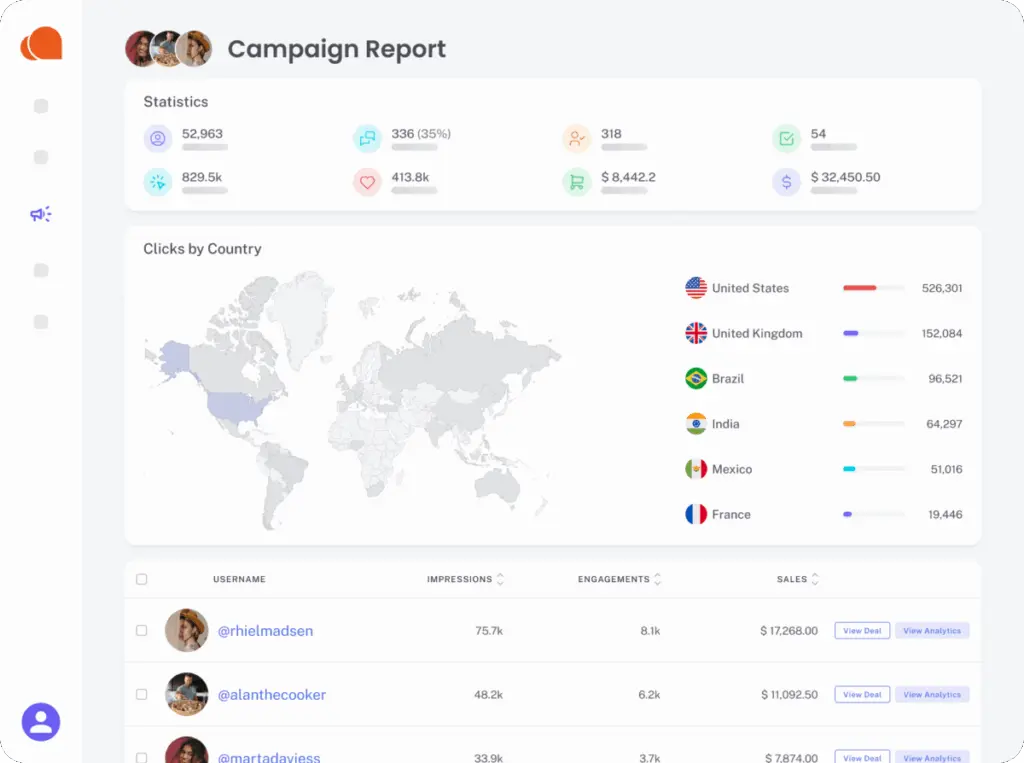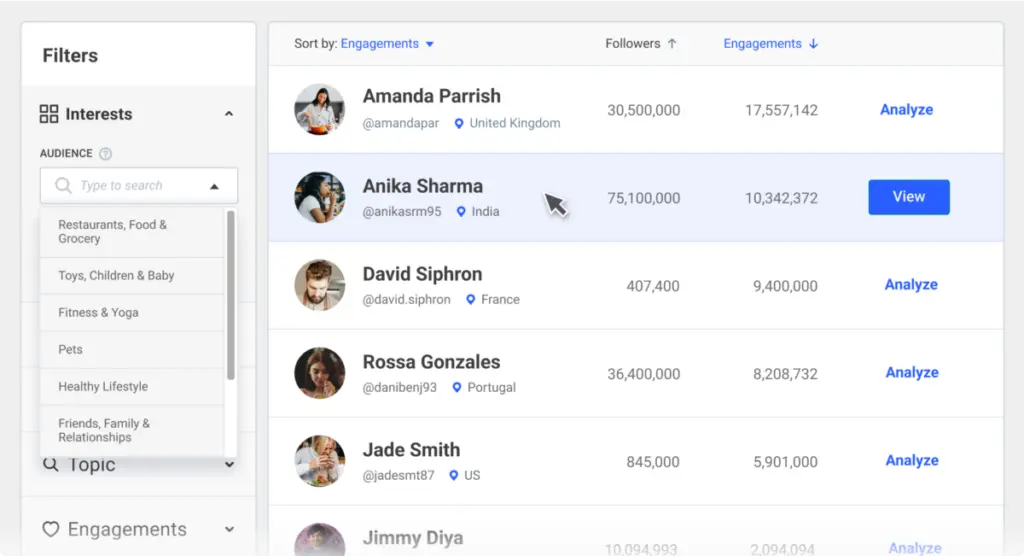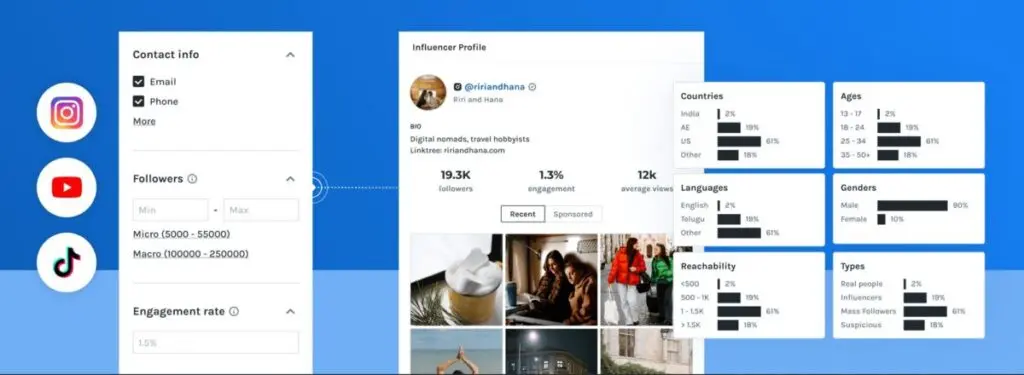Influencer discovery has outgrown hashtag scrapes. Today’s buyers face two hard questions:
- Do you need raw scale or verifiable audience quality?
- How quickly can you move from a fuzzy brief to a defensible shortlist?
Across the market, we’re seeing AI/semantic search, lookalike expansion, and topic-led exploration replace manual hunting, while audience-first filters (geo, language, age, interests) and fraud/credibility scoring purge false positives early.
Discovery no longer stands alone; the stronger platforms push straight into IRM, campaign ops, and commerce attribution (Shopify codes, GA, affiliate), closing the loop from “find” to measurable revenue. Multi-network coverage is now table stakes, but the differentiator is how each tool balances breadth with speed, transparency, and data freshness.
This article’s intent: to evaluate discovery platforms with 10M+ profiles on what matters to marketers—how they shorten time-to-fit, raise shortlist quality, and plug into activation/measurement—so you can pick the right tool for your bottleneck today.
1. Modash
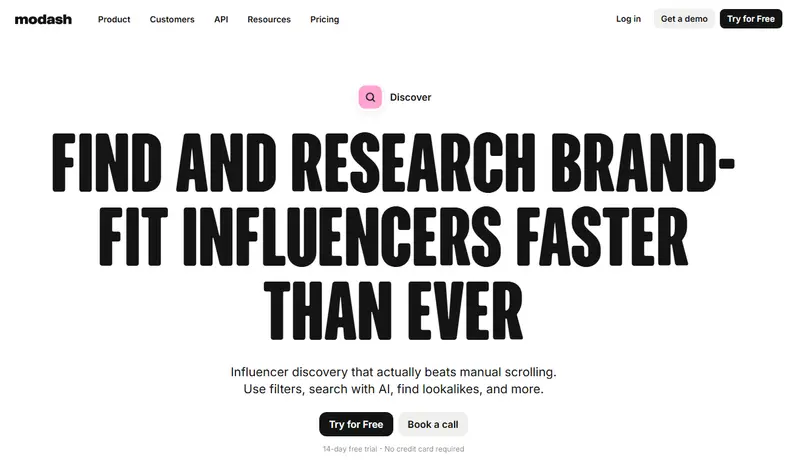
Best for: Brands of all Sizes
Platforms Supported: Instagram, TikTok, YouTube
Pricing: 14-day free trial. Essentials from $199/mo billed yearly (or $299 monthly); Performance from $499/mo billed yearly (or $599 monthly); Enterprise: Custom pricing.
Available filters: Follower range, engagement rate, creator location (country/city), creator language, bio keywords, hashtags used, brand mentions, interests/niche, audience location (country/city), audience age/gender, audience language, audience credibility/fake-follower flag, growth rate, lookalikes, and platform.
Modash is an influencer discovery and analysis platform focused on helping marketers identify creator–audience fit quickly across major social networks. It indexes 350M+ creator profiles across Instagram, TikTok, and YouTube, which is among the largest searchable datasets available to buyers today.
That scale, combined with natural-language AI search and lookalike expansion, positions Modash as a breadth-first discovery tool that still provides audience and credibility detail for shortlist decisions. Teams with engineering needs can extend workflows via documented Discovery and RAW APIs.
Influencer Discovery Features
Discovery starts with natural-language AI search (“describe it, find it”), which parses creator content and context without forcing you to pre-guess hashtags. In practice, this trims the first pass from hours to minutes: type the brand brief, get a relevant seed set, then layer structured filters to tighten to the right geo, language, and audience makeup.
Lookalike search then scales winners by finding creators with similar content or audiences, which is effective when you’ve proven a creative angle and want to replicate it in adjacent markets.
Shortlisting quality depends on trustworthy data. Modash surfaces creator metrics (engagement, growth), audience demographics (age, gender, language, city/country), past sponsorships/mentions, and an audience credibility signal for fake-follower risk—useful for cutting low-quality reach before outreach.
Audience/location weighting and multi-location inputs help refine cohorts when campaigns require precise regional splits.
Workflow accelerators include list building, contact discovery, and CSV/API exports; engineering teams can shift between Discovery (search-optimized) and RAW (real-time, unfiltered) endpoints depending on freshness needs.
Transparency worth noting: Indexing focuses on public IG/TT creators with ~1k+ followers, and API docs disclose update cadences—e.g., Search/List refresh monthly while Reports refresh every 2–4 weeks—so build processes that fall back to the Reports endpoint when you need the newest stats.
Case Study
BioTechUSA (consumer fitness/nutrition) needed to scale repeatable micro and nano-influencer pipelines across markets without sacrificing audience fit. Burga (DTC accessories) needed internal consensus on one discovery stack; an independent consultant required faster, cleaner vetting for multiple client programs.
Each team started campaigns inside Modash’s discovery workflow—using AI search to generate seed lists, then layering geo, language, and audience filters; credibility checks and growth trends trimmed low-quality reach; lookalikes replicated proven creators into adjacent markets. Lists and exports fed outreach.
BioTechUSA reports contracting 70+ influencers and 500+ nano influencers and is preparing to scale internationally. Burga’s internal poll showed 17/23 staff selecting Modash as their top tool.

Key Features: Campaign Management, Influencer Discovery, Influencer Analytics, Influencer Campaign Monitoring, Influencer Management,
2. HypeAuditor
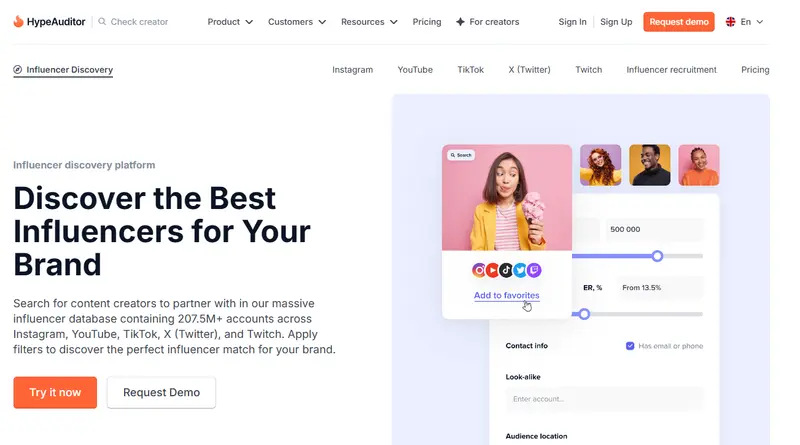
Best for: Small, Medium, and Large Brands, Agencies
Platforms Supported: Instagram, YouTube, TikTok, X (Twitter), Twitch
Pricing: Custom pricing (request demo). Free tools and demo access available
Available filters: Keywords/hashtags, platform, influencer size (nano→mega), follower range, engagement rate, creator location, creator category/niche, growth rate, audience location (country/city), audience age/gender/ethnicity, audience language, interests, AQS/quality thresholds, brand mentions/ambassador signals, lookalikes.
HypeAuditor is an influencer discovery and analytics platform built around audience-level trust and scale. Its index covers 207.5M+ creator accounts spanning Instagram, YouTube, TikTok, X, and Twitch, giving buyers broad coverage for multi-market searches.
Core to its positioning is Audience Quality Score (AQS) for authenticity screening, paired with keyword/hashtag search, niche discovery, and lookalike expansion to turn strong seeds into larger, relevant cohorts. For teams that integrate data into BI or workflows, HypeAuditor exposes an API alongside CSV exports and a Chrome extension.
Influencer Discovery Features
Discovery starts with flexible inputs—plain-language keywords or hashtags—and quickly narrows via audience-first filters (location, age, gender, ethnicity, interests) to match the message to the right viewers, not just the right creator persona.
That combination is useful when briefs demand precise demographics across regions or when you need to benchmark against competitors and recruit brand ambassadors who are already mentioning your products. The lookalikes feature then scales what works by mapping similar creators in style, audience behavior, or niche, so you can replicate success without guesswork.
Shortlisting quality hinges on fraud and relevance checks. Here, the AQS framework helps triage accounts by audience authenticity, engagement health, and growth signals—removing low-quality reach before outreach and helping defend selections internally. Teams can also target fast-growing or niche accounts to uncover rising, cost-efficient partners before rates spike.
Operationally, lists support collaboration and handoff: build longlists, refine to shortlists, export to CSV, then push straight into outreach/campaign modules when you’re ready to activate.
HypeAuditor documents weekly report refreshes for most creators (with more frequent updates for highly active profiles) and publishes API rate-limit guidance—useful when you’re scheduling bulk enrichments or automated vetting.
Case Study
Bekina Boots, a Belgian work-boot manufacturer, needed to find values-aligned creators across multiple countries, verify audience authenticity, and coordinate influencer outreach in one place as collaborations scaled. The team prioritized sustainability alignment, genuine engagement, and country-by-country targeting.
The collaboration started in Influencer Discovery to build longlists using Audience Quality Score (AQS), Account Growth Rate, Audience Type, and category filters; those lists were then narrowed to shortlists by country. Creators were organized in My Network with tags and stages to manage handoffs, while Campaigns and Messages centralized communication and tracking across languages.
A Chrome browser plug-in supported faster prospect review and outreach from web contexts without losing the HypeAuditor record. Throughout, AQS and growth signals acted as the gating criteria to keep only authentic, on-brand candidates.
The workflow produced faster, more confident selection (fewer false positives reaching outreach), structured global outreach via country-specific lists and plugin-assisted prospecting, and measurable impact through tracked reach and engagement to monitor brand awareness by market.

Key Features: Search/Discovery, Campaign Reporting, Influencer Analysis, Audience Analysis, White Label Reporting, Fake Follower/Fraud Detection,
Channels: Instagram, YouTube, TikTok, Twitch, Twitter
3. Influencer Hero
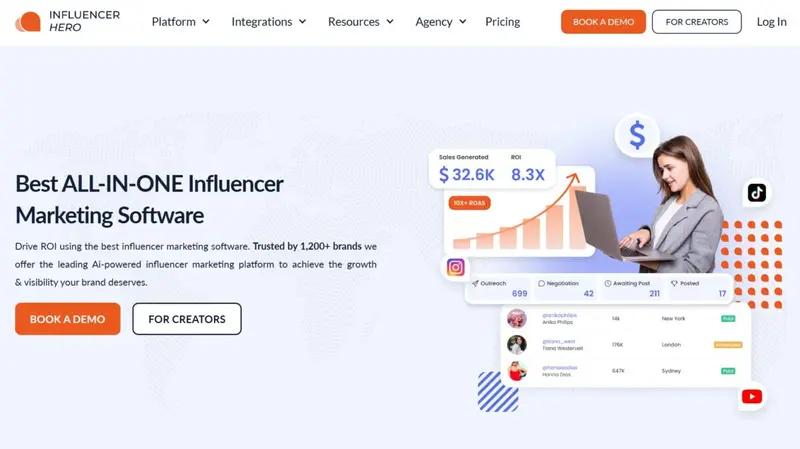
Best for: Performance-focused DTC and ecommerce brands, plus agencies running high-volume gifting and affiliate programs who want discovery, outreach, seeding, tracking, and payouts in one workflow.
Platforms Supported: Instagram, TikTok, YouTube (with broader support for Facebook, Pinterest, Snapchat, X, and Twitch across campaigns).
Pricing: No free plan for the core platform. Brand subscriptions start at $649/month (Standard), $1,049/month (Pro), and $2,490/month (Business) on monthly contracts. When billed yearly, pricing drops to $454/month (Standard), $734/month (Pro), and $1,743/month (Business). Custom and agency plans are available.
Available filters (high level): Creator location, follower range, engagement rate, creator niche, audience demographics, authenticity/fake-follower signals, lookalikes, and high-intent sourcing such as creators who already follow or overlap with brand-owned channels.
Influencer Hero positions itself as an operating system for influencer marketing rather than a single-purpose discovery tool. Its core idea is simple: influencer programs break down not at the creative level, but at the operational one—outreach, logistics, tracking, and payouts. The platform is designed to keep all of that inside one system, from first search to final payment.
Discovery is built around scale and intent. Alongside standard filters, Influencer Hero emphasizes sourcing creators who already have a relationship with the brand—such as followers or newsletter subscribers—helping teams prioritize higher reply rates and faster activation. Lookalike discovery supports replication once a winning creator or format is identified, making it easier to scale campaigns across markets.
Outreach is treated as a pipeline, not a blast. Automated drip campaigns, AI-assisted personalization, and follow-ups are core to how the platform expects teams to operate at volume. Deliverability and inbox placement are explicitly part of the value proposition, which matters at the reach-out limits the higher tiers support.
Once creators are active, the CRM becomes the system of record. Each creator has a deal page that combines communication history, product send-outs, affiliate links or codes, performance metrics, and content assets. Shopify integration enables product seeding directly from the platform, reducing manual coordination and keeping shipping tied to campaign timelines.
Affiliate tracking and payouts are positioned as first-class features rather than add-ons. Brands can generate links and discount codes, track conversions via cookies, and process influencer payouts at scale. Creator dashboards give influencers visibility into performance and earnings, reducing reconciliation friction and back-and-forth.
Reporting focuses on ROI and operational clarity: impressions, clicks, sales attribution, UGC volume, and gifting activity are centralized so teams can evaluate what’s working and double down quickly. This is especially relevant for brands treating influencer marketing as a performance channel rather than a pure awareness play.
Integrations are a key part of why the system holds together. Influencer Hero connects with ecommerce platforms like Shopify, WooCommerce, and Magento, as well as email and workflow tools such as Gmail, Outlook, Klaviyo, and Zapier—allowing influencer campaigns to run inside existing brand infrastructure instead of alongside it.
Influencer Hero isn’t trying to win on aesthetics or niche specialization. Its strength is operational: collapsing discovery, outreach, seeding, tracking, and payouts into a single workflow that can scale. For ecommerce brands and agencies that care about links, codes, logistics, and measurable outcomes, that focus is exactly the point.

Key Features: Influencer Search & Discovery, Relationship Management, Campaign Management, Influencer Outreach and Engagement, Performance Tracking with Audience Demographics and Conversion Attribution, Global Influencer Payment, Fraud Detection and Audience Health, Team Collaboration Tools, Content Library, E-commerce Tools, Product/Gifting Tools, Forms and Compliance, Competitor Research, Exportable reports, Affiliate Management,
Channels: Instagram, TikTok, and YouTube
4. Influencity
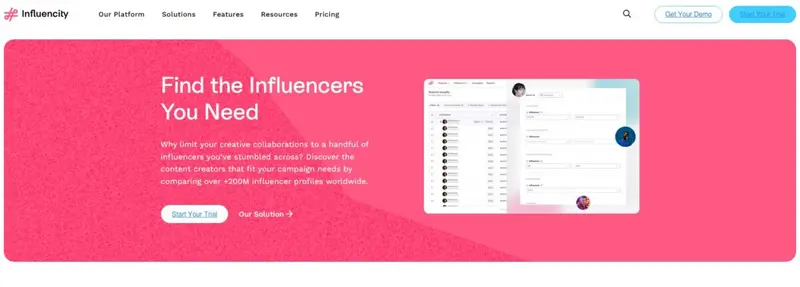
Best for: Any size business or agency
Platforms Supported: Instagram, TikTok, YouTube
Pricing: Free trial available; Custom pricing
Available filters: Topics (trending themes), Lookalikes, keywords/hashtags, influencer follower range, six-month growth rate, average interactions/plays, engagement rate, creator location, creator category/niche, audience location (country/city), audience age/gender/language, brand affinity/mentions, authenticity/fake-follower indicators, and platform.
Influencity is a discovery-led AI influencer marketing platform with a 200M+ profile index and an emphasis on turning vague briefs into qualified shortlists fast. Its Topics filter doubles as an idea generator when you know the vertical but not the angle, while Lookalikes helps replicate a target aesthetic within specific budget and geo constraints.
Discovery ties into IRM, Campaigns, and reporting, with Shopify integration for seeding workflows. Recognition includes industry presence as an official trophy sponsor of the 2025 Global Influencer Marketing Awards.
Influencity has also won a prestigious Digiday Award for Best Influencer Marketing Platform.
Influencer Discovery Features
Discovery centers on two levers: Topics to explore what’s trending around a theme and Lookalikes to mirror the style or audience of a favorite creator without overpaying. In practice, that’s how teams move from a broad prompt (“family products,” “budget travel,” “healthy lunch”) to a bank of on-brief options, then scale a winning format across markets using audience and follower-tier constraints.
Data available at shortlist time includes creator growth (e.g., six-month deltas), average interactions and reel/short views, and audience demographics, languages, and geos—plus fake-follower and brand-affinity indicators surfaced in Profile Analysis. That combination trims false positives before outreach and makes it easier to defend selections to non-marketing stakeholders.
Workflow gains come from clean list→analysis handoff and exports into IRM/Campaigns; ecommerce teams can connect Shopify to run product-seeding at scale without leaving the platform. Teams that work cross-market tend to start with Topics to map angles, then apply Lookalikes and audience/location gates to produce region-ready shortlists in one pass.
Case Study
Alkimiads needed to systematize sourcing and vetting while forecasting campaign impact—notably for the Karol G “Mañana Será Bonito” launch and a PlayStation 5 revival. Manual hashtag searches and one-by-one vetting were too slow to meet client timelines.
Influencity replaced manual first-pass searches with Topics and audience gates to generate longlists, then Profile Analysis to screen creators on aesthetic, tone, prior sponsorships, and authenticity.
Lookalikes replicated proven aesthetics within follower and geo constraints. Lists and Campaigns produced quick, shareable forecasts (reach/interactions/EMV), while Audience Overlap views kept unique reach high.
For the two campaigns combined, Alkimiads delivered 142.7M impressions and 7.9M interactions across 30 influencers. Search time fell by 55% (25-minute searches yielding ~15 viable profiles vs. 45 minutes for ~5), viable profiles per search rose 200%, and profile KPI review time dropped by ~50% thanks to visual dashboards—clear evidence that discovery quality and speed were central to the outcome.

Key Features: Search/Discovery, Influencer Lifecycle Management, Influencer Relationship Management, Campaign Management, Campaign Reporting, Influencer Analysis, Audience Analysis, Fake Follower/Fraud Detection, Exportable reports, Team/Collaboration Tools,
Channels: Instagram, YouTube, TikTok, Twitch
5. Brandwatch Influencer Marketing Software
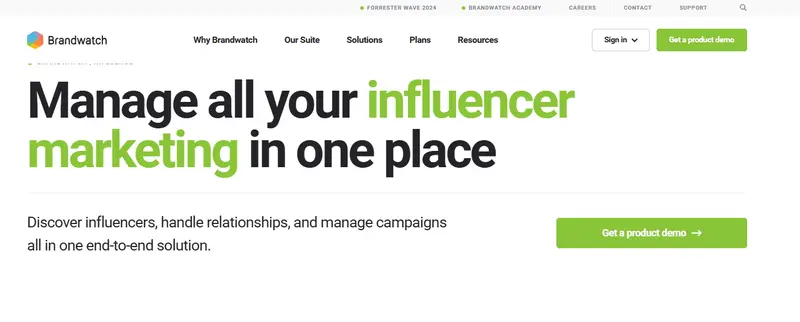
Best for: Medium to Large organizations and Agencies
Platforms Supported: Instagram, TikTok, YouTube, X (Twitter), Twitch, Facebook
Pricing: Custom pricing
Available filters: Platform, interests/topics, keywords, brand affinities, prior brand work, credibility/quality flags, creator location, follower tiers, engagement rate, language, and roster/CRM fields.
Brandwatch Influence is the influencer stack inside the broader Brandwatch suite, designed to take you from social listening to discovery to activation in one place. The discovery index lists 24M+ global creators, and the workflow continues into a CRM-style directory, campaign reporting, and integrated payments.
Notable recognition includes Digiday Technology Awards wins in 2023 (Best Influencer Marketing Platform) and 2024 (Best Social Marketing Platform), plus MarTech Breakthrough 2024 (Best Social Media Monitoring Software). Those awards reflect Brandwatch’s positioning at the intersection of data depth and operational execution.
Brandwatch is also a Meta Business Partner, LinkedIn Marketing Partner, X Official Partner, and TikTok Marketing Partner, further cementing their expertise.
Influencer Discovery Features
Discovery zeroes in on fit rather than just follower counts. Filters cover interests, brand affinities, and prior brand work, which makes it easier to build shortlists aligned to category context or competitors—useful when you’re swapping creators between product lines or markets.
A credibility/quality screen helps you push low-trust accounts out of the funnel early, so outreach time goes to candidates with real reach.
What differentiates the discovery step here is the proximity to Brandwatch’s listening and analytics. Teams can mine topic/hashtag conversations to surface non-obvious voices, then jump into Influence to evaluate creator-level metrics and manage handoff into IRM and campaigns.
For activation-heavy teams, the end-to-end setup (lists → briefs → deliverables → reporting) means you can keep all creator profiles, contracts, and content milestones linked to the same record—handy when multiple geos and product lines are in-flight.
Case Study
Jack in the Box (QSR) needed to identify additional influencers beyond its existing roster and understand audience interests driving fast-food conversation in a highly competitive category.
Using Brandwatch Analytics, the team built keyword queries around the brand, competitors, and menu items to surface influential authors and hashtags. Hashtag analysis during the Super Bowl push highlighted #DeclarationOfDelicious as a top conversation driver, with roughly 90% of usage coming via retweets—evidence of strong passive amplification.
Author analysis surfaced high-reach creators (e.g., Miranda Sings) and local media personalities; demographic insights showed sports as a dominant audience interest, pointing to content and partnership angles beyond food-only chatter.
The work expanded Jack in the Box’s influencer map, clarified which creators and cultural interests moved the conversation, and informed future lineup decisions. While this case predates the current Influence UI, it demonstrates how Brandwatch’s listening-led approach feeds discovery: mine conversations to find credible voices, then operationalize selection, briefs, and measurement in the influencer stack.

Key Features: Global Influencer Payment, Influencer Discovery, Influencer directory management, Creation of private influencer network, Campaign management and reporting, Broad platform coverage, Automated reporting,
Channels: YouTube, Facebook, Instagram, Twitter, Twitch, TikTok, Shopify
6. Creator.co
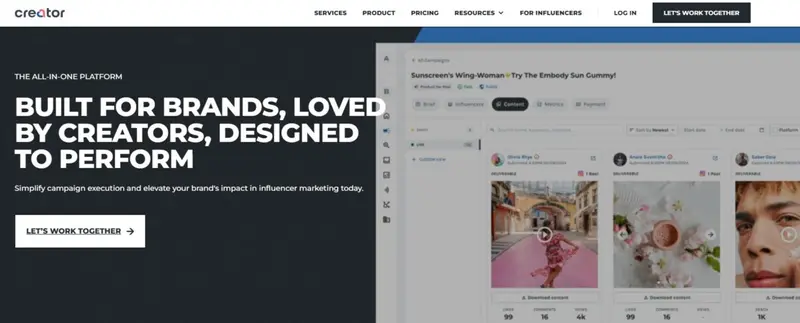
Best for: Brands and Agencies of all sizes
Platforms Supported: Instagram, TikTok, YouTube
Pricing: Free demo available; enquire about full pricing
Available filters: Platform, keywords/niche, creator location, audience location, audience age/gender, audience interests, follower tier, engagement/interaction averages, language, and list-level dedupe/overlap checks; plus opt-in applications via the Collaboration Hub.
Creator.co combines large-scale discovery with built-in activation, attribution, and a self-serve Collaboration Hub where 250k+ opt-in creators can apply to briefs. Behind that opt-in network sits a 300M+ creator index for search and invites, giving teams breadth for prospecting and a quicker on-ramp for recruitment.
The stack links discovery to Google Analytics sync, Shopify coupon-code tracking, and affiliate network integrations (Rakuten, Awin, ShareASale, Impact) so performance and payback are visible past vanity metrics. In a crowded market, that “from find → ship → track ROAS” loop is the differentiator for commerce-driven programs.
Creator.co was just recently nominated for Best Creator Strategy by Commussion Junction.
Influencer Discovery Features
Creator.co’s discovery starts with AI-assisted search across Instagram, TikTok, and YouTube, letting you enter keywords or niches and immediately constrain results by geography and audience demographics. In practice, that means fewer manual hashtag scrapes and faster movement from brief to a defensible longlist that matches where buyers actually are.
The Deep Insights report sits on the discovery step—before outreach—so you can validate creator–audience fit without exporting to other tools. You get audience breakdowns (location, age, gender) and performance indicators that help you separate aesthetic matches from accounts that are unlikely to convert, tightening the shortlist with data rather than intuition.
Discovery also has an inbound track: the Collaboration Hub. Publish a brief and qualified, opt-in creators (250k+) can apply; you can then screen applicants against your demographic and niche criteria and move accepted creators straight into lists. This complements outbound search when you need both targeted prospecting and a steady stream of on-brief applicants.
For teams sourcing at scale, curated Lists keep discovery organized and reusable across campaigns; you can build them yourself or request expert-curated lists to accelerate the first pass when timing is tight or categories are unfamiliar. The net effect is a discovery layer that reduces top-of-funnel hours and raises shortlist precision before activation begins.
Case Study
Taos Footwear and agency Gen3 Marketing needed creator content that felt organic and outperformed branded ads across paid channels. Recruiting on-brief lifestyle storytellers and attributing sales impact were the blockers.
The team used Creator.co to source lifestyle creators aligned to aesthetic and audience criteria, then activated via the Collaboration Hub and in-platform messaging. Product seeding and fulfillment ran through Shopify; performance stitched together in the dashboard with GA/affiliate widgets so tests could be A/B’d by creator, style, and hook.
50+ assets generated outcomes that beat branded content in ad tests, with 30,000 views, 22,000 reach, 200+ shares, 300+ saves, 500+ comments, and $5,634 EMV. The team left with a reusable bank of winners for future iterations—evidence that discovery tied to activation and attribution shortened the path from sourcing to ROAS.

Key Features: Search/Discovery, Automated Recruiting, Influencer Relationship Management, Influencer Marketplace, Content Review, Content Library, Campaign Management, Campaign Reporting, Influencer Analysis, Audience Analysis, E-commerce Tools, Product/Gifting Tools, Fake Follower/Fraud Detection, Payment Processing, Social Listening, Competitor Research, Creator Marketplace,
Channels: Instagram, YouTube, TikTok
7. IQfluence

Best for: Large Brands and Agencies
Platforms Supported: TikTok, Instagram, YouTube
Pricing: 7-day free trial; Starter from $236/mo (annual) or $295/mo (monthly); higher tiers available
Available filters: Platform; keywords/mentions/hashtags; creator location (country/city); languages; gender; follower range; engagement rate; saves/shares; growth; lookalikes; audience location, age/gender, language, interests, brand affinity; authenticity flags (suspicious accounts, mass followers).
IQFluence is an AI-driven discovery platform with a 375M+ creator index spanning TikTok, Instagram, and YouTube. It pairs conventional filters (country/city, language, follower/engagement bands) with audience analysis and authenticity checks to screen for fit before outreach.
Recent updates emphasize semantic search that reads video subtitles and descriptions to match topic intent, which matters when keywords alone miss context. Positioning-wise, IQFluence leans into fast, on-brief sourcing plus pre-outreach audience vetting and lookalikes.
Influencer Discovery Features
IQFluence minimizes “hashtag guesswork” by offering city-level filtering and niche inputs (keywords, mentions, hashtags) across TikTok, Instagram, and YouTube, then layering creator and audience constraints (age, gender, language, interests, brand affinity). That combination is useful for briefs that require, say, Los Angeles-based creators with a Spanish-speaking audience and skincare interest—without hopping tools.
Where it differentiates is the Semantic AI Search: instead of simple keyword matches, IQFluence analyzes subtitles and descriptions to understand what creators actually talk about. For travel queries such as “Patagonia,” semantic matching prevents false positives from generic “#travel” posts and surfaces consistently on-topic channels.
IQfluence says the introduction of Semantic AI search has resulted in 68% more relevant creators and 62% faster niche discovery since launch. Treat those gains as directional until you validate against your briefs.
Pre-outreach, IQFluence’s audience reports flag suspicious accounts and mass followers, and expose location split, age/gender, languages, interests, and brand affinity—handy for cutting low-quality reach before negotiations.
On the creator side, you can filter by engagement rate, follower bands, saves/shares, growth, and run lookalikes to scale a proven aesthetic within target tiers or geos. Lists and exports keep sourcing reusable across campaigns.
Case Study
Tiege Hanley (men’s skincare) needed a steadier flow of qualified creators that actively discussed specific themes, plus faster, data-driven vetting at scale.
The team used IQFluence’s gender and audience filters, keyword/topic search, and lookalikes to build platform-specific longlists (with follower/view minimums), then applied audience reports to confirm fit before outreach—shifting effort from manual hunting to higher-value negotiations.
Reported outcomes include a 400% increase in prequalified influencers identified per week with only a 100% increase in resourcing, and a smoother onboarding funnel with improved work-life balance—evidence that discovery throughput, not just activation, was the bottleneck IQFluence helped unlock.

Key Features: Influencer Search & Discovery, Campaign Reporting, Analytics/Reporting,
Channels: Instagram, TikTok, YouTube
Discovery, Differentiated: How to Pick the Right Tool
Across these five platforms, “best” depends on whether you prioritize scale, authenticity checks, idea generation, listening-led signals, or commerce attribution. If your brief spans multiple countries and relies on micro-influencers, you’ll value dataset breadth and speed to a defensible shortlist.
If you face internal scrutiny around fake reach, fraud screening matters more than sheer volume. Where briefs are fuzzy, tools that turn topics into candidates save hours; where your team is performance-driven, closing the loop from discovery to sales is the deciding factor.
Finally, if social listening already underpins your brand strategy, a discovery layer that speaks the same language (queries, intent, sentiment) will feel native and reduce handoffs.
Biggest strength by tool:
- Modash: Unusually large, searchable creator coverage that accelerates global micro-influencer sourcing.
- HypeAuditor: Audience Quality Score (AQS) for rigorous authenticity and fraud screening at shortlist time.
- Influencity: “Topics” exploration that converts vague ideas into on-brief creator options you can scale with lookalikes.
- Brandwatch Influence: Discovery that plugs directly into social listening insights for conversation-led shortlists.
- Creator.co: Commerce attribution loop (Shopify codes, GA, affiliate) that ties discovery to ROAS, not just reach.
- IQFluence: Semantic AI search (subtitle/description parsing) plus city-level filters to surface truly on-topic, location-specific creators at scale.
Match the tool to the bottleneck you actually have—finding enough on-brief creators, proving audience quality, turning ideas into candidates, grounding choices in listening data, or attributing revenue—and you’ll avoid overpaying for features you won’t use.
Frequently Asked Questions
What should I try first if I’m on a near-zero budget?
Start by auditing your stack with curated lists of free influencer marketing tools to cover discovery, outreach, and tracking basics before you commit to a paid platform.
How do small businesses pick a platform without overbuying?
Map must-have filters and basic CRM needs, then compare vendor fit against roundups of platforms for small businesses to avoid paying for enterprise features you won’t use.
Which workflows are worth automating first?
Automate repetitive sourcing and outreach steps—list building, email sequences, and status updates—using guides on how to automate influencer marketing to keep teams focused on strategy and creative.
What does a minimal tracking stack look like?
Pair link tracking and promo codes with a reporting cadence informed by track influencer campaigns so attribution survives channel and format changes.
When do marketplaces make more sense than databases?
If speed and inbound supply matter, shortlist opt-in influencer marketplaces where creators apply to briefs, then backfill gaps with database search.
How can discovery align with content strategy?
Use content discovery tools to surface formats and topics winning in your niche, then mirror those signals in creator filters and briefs.
Which KPIs actually move decisions?
Agree on a small set—e.g., reach quality, engagement efficiency, and conversion proxies—using definitions from influencer marketing KPIs to keep reporting consistent.
What common sourcing mistakes should teams avoid?
Skip follower-count tunnel vision and misaligned audiences by following the finding influencers dos and don’ts when you draft queries and vet shortlists.

